Green grass not only looks good, but it is also a sign of good lawn health.
You must have heard the expression, “the grass is always greener on the other side of the fence.” Now we are not saying that it is always the case, but let’s be honest, most people think that and are constantly comparing their lawns to their neighbors’. I mean, who doesn’t love a green lawn? It is attractive, and it is a sign of good lawn health.
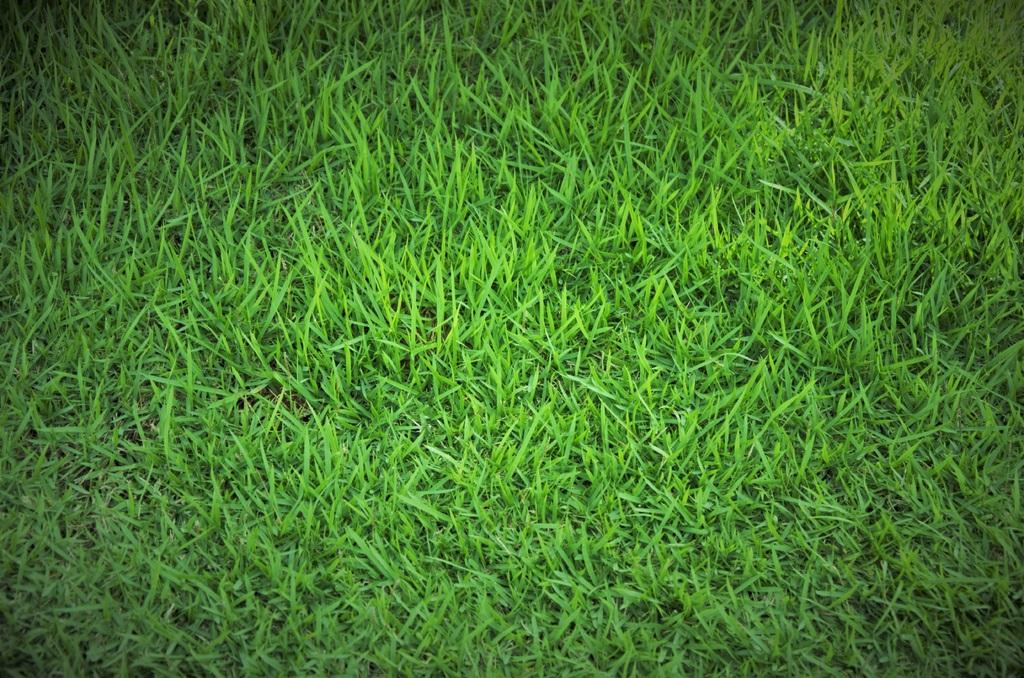
Establishing a lush green lawn takes some time and effort to achieve. However, it is surprisingly simple, easy, and worth the effort. All you have to do is learn some basics about the grass and put in a few hours of light labor whenever the peak growing season arrives. And soon, you will have a lawn that all your neighbors envy!
Making your lawn green starts with choosing the right grass. The choice will vary depending on where you live and the type of soil in your yard. Then, it is just a matter of adequately fertilizing, watering, mowing, weeding, and caring for your lawn, and soon grass will be greener on both sides of the fence.
So, if you are willing, let’s discuss this in more detail! You will provide the labor, and we will provide the know-how!
How Can I Make My Grass Greener And Thicker?
Know Your Grass
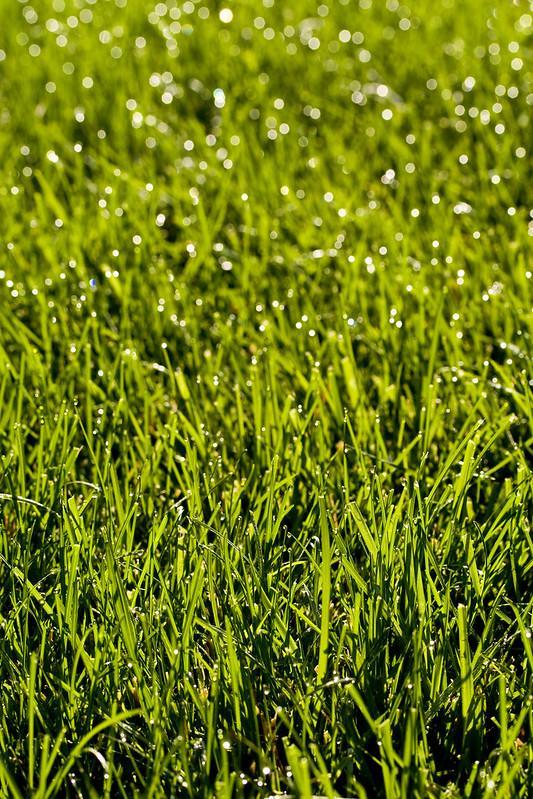
Bermuda grass: A warm-season species that grows best in warm climates.
For most people, the grass is just grass! However, it is important to understand that there are dozens of types, and every grass has its requirements in which it grows the best. And if you grow grass out of its ideal zone, you will have to work way harder to keep it green, and there’s a chance it might still not work. Generally speaking, turfgrasses are divided into two broad categories: Cool-season grasses and Warm-season grasses.
| Warm-season grasses | Cool-season grasses |
|---|---|
| These grasses grow best in the southern and southeast regions of the United States. They generally turn brown when temperatures fall below 55°F. | These grasses grow best in the north, northeast, and most of the Midwest of the United States. They flourish in temperatures between 65 to 80°F. |
| Examples – Bermuda grass – Bahia grass – Centipede grass – St. Augustine grass – Zoysia grass | Examples – Bentgrass – Kentucky bluegrass – Tall Fescue grass – Annual ryegrass – Perennial ryegrass |
Grass Tolerances
| Cool-season grasses | ||||
|---|---|---|---|---|
High Low |
Heat tolerance | Drought tolerance | Cold toleranc | Shade tolerance |
| Tall fescue grassTall fescue grass Fine fescue grass Kentucky bluegrass Perennial ryegrass |
Tall fescue grass Fine fescue grass Kentucky bluegrass Perennial ryegrass |
Kentucky bluegrass Perennial ryegrass Fine fescue grass Tall fescue grass |
Fine fescue grass Tall fescue grass Kentucky bluegrass Perennial ryegrass |
|
| Warm-season grasses | ||||
High Low |
Heat tolerance | Drought tolerance | Cold toleranc | Shade tolerance |
| Bermuda grass St. Augustine grass Zoysia grass Bahia grass |
Tall fescue grass Bermuda grass Bahia grass Zoysia grass St. Augustine grass |
Zoysia grass Bermuda grass Bahia grass St. Augustine grass |
Zoysia grass St. Augustine grass Bahia grass Bermuda grass |
|
Test Your Soil
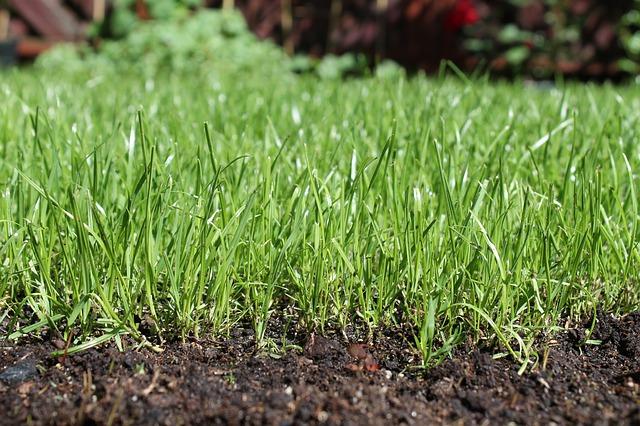
Ideally, you should test the lawn soil every year to see if it lacks any nutrients.
Once you have selected a grass that you want to grow in your backyard, the next step is to test the properties of your soil. This, combined with the type of grass you have chosen to grow in your yard, will help you determine what you are missing for optimum grass growth.
When it comes to nutrients, nearly every grass has its preference. So, getting a soil test will help you determine what it needs to get greener. Soil testing kits are available readily and widely. You can buy them from your local gardening stores or an online retailer.
Generally speaking, most grasses grow well in soil with a slightly acidic pH (between 6 to 7) and abundant nitrogen, phosphorus, and potassium. However, warm-season grasses usually prefer somewhat lower pH than cool-season grasses.
However, the ideal growing conditions, such as soil pH and nutrient levels, will vary depending on your grass. So, make sure you find that out!
Fertilize Adequately & Correctly

Using too much fertilizer can cause grass burns which will ruin the aesthetics of your turf.
Now that you know what nutrients your lawn soil lacks, you can buy the best fertilizer suitable for your soil. Nearly every fertilizer contains nitrogen, potassium, and phosphorus. However, the ratio of these nutrients varies.
The ratio is indicated as the NPK number on the fertilizer bag. This number will help you choose a fertilizer that balances out the nutrient levels in your lawn soil. In addition, some fertilizers also come with valuable extras such as added iron, weed killer, etc.
Best Time To Fertilize Your Lawn
The ideal time to fertilize also varies between different grass types. For instance, cool-season grasses should be fertilized in early spring or fall. In contrast, warm-season grasses should be fertilized in later spring or anytime during the summer.
Fertilizing the grass at the proper time will help you get the best out of it, and it will keep your lawn looking green for an extended period of time. Also, avoid over-fertilizing your lawn. It can cause grass burns and ruin your turf.
Organic Fertilizers
If you do not want to use chemical fertilizers on your lawn, natural and eco-friendly options are available. You can either purchase organic fertilizer for your lawn or spread a thin layer of compost over your grass during the peak growing season.
Apply Iron To Your Lawn
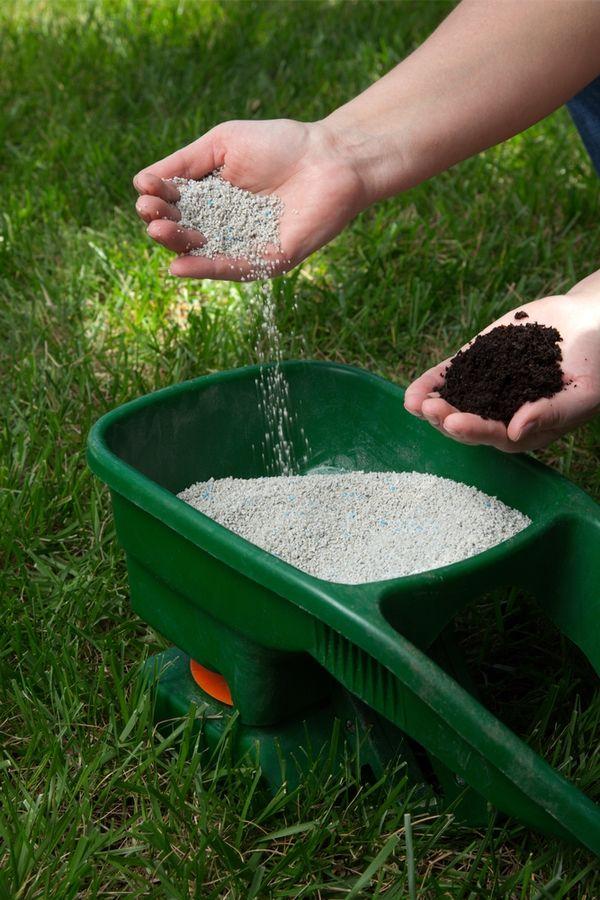
Iron application makes grass greener without extra growth.
If you want your grass to get green quickly, applying iron is one of the best tricks. Iron enhances oxygen transport and chlorophyll production in the grass, which makes the grass vivid and dark green in a matter of just a few days.
Greening your lawn by using iron is effective for every grass type. However, fescue grass and tall fescue grass do especially well with iron application. Like fertilizers, iron supplements are also available in synthetic and organic forms.
Commonly used iron fertilizers include Dr. Iron, Ironite, and Milorganite. Dr. Iron and Ironite are synthetic fertilizers. They produce results quicker but using too much can be harmful. Milorganite, on the other hand, is an organic option but can be slow in action.
RELATED: How and When To Use Ironite In A Lawn For Best Results?
Maintain A Consistent Watering Schedule
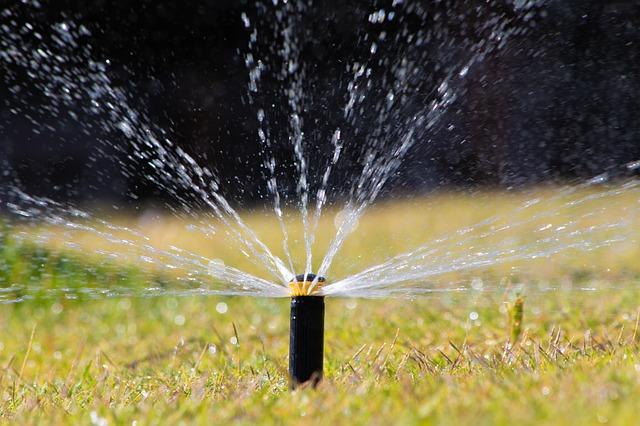
On average, lawns need about an inch of water every week.
Watering your grass correctly and adequately is as important as fertilization. And, you need to understand that turning your sprinklers on every day for a few minutes won’t do it! You have to water your grass adequately and at a proper time to keep it green.
When the grass seeds are germinating, water your lawn as needed to keep the soil moist. However, once the grass is about an inch tall, you should water it less frequently but deeply. It will promote deep root growth and help the grass stay green even in the drought for quite a bit of time.
That said, the soil in your yard also greatly impacts the recommended watering frequency and duration of each watering session.
Watering Clay Soils
Clay soils tend to hold water for longer and need to be watered less frequently and for smaller durations. It is because they also take longer to absorb the water. Read this article to learn about the grasses that grow best in clay soil.
Watering Sandy Soils
Sandy soils absorb water quickly; however, they also tend to lose moisture very quickly as well. So, you will need to water frequently and deeply. We also highly recommend that you top-dress your sandy soil lawn with compost to improve the soil quality.
Mow Your Lawn Correctly
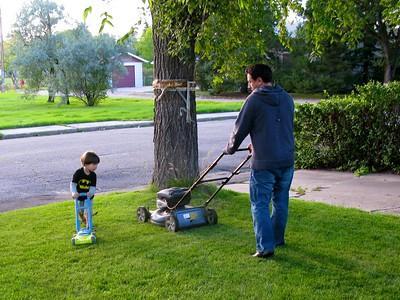
Avoid cutting more than one-third of grass blades with any single mowing session.
If you want your lawn to look clean, green and serene, you must mow it at a proper height. Some articles on the internet suggest mowing the grass low and frequently; however, it is not quite right. Every grass has its requirements when it comes to mowing height.
As a rule of thumb, never cut the grass more than one-third of its original length in any single mowing session. Moreover, mow your grass when it is dry and use sharp blades. This will keep the grass green and healthy and prevent it from falling victim to lawn disease.
We also highly recommend that you buy a reel mower for cutting your grass. A reel mower cuts the grass like scissors rather than tearing it, which keeps the grass looking better and healthier in general.
Proper Mowing Heights For Different Grasses
| Grass Type | Mowing Height | Grass Type | Mowing Height |
|---|---|---|---|
| Kentucky bluegrass | 1 1/2″ to 2 1/2″ | Fescue grass | 1 1/2″ to 2 1/2″ |
| Annual Ryegrass | 1 1/2″ to 2 1/2″ | Tall Fescue grass | 1 1/2″ to 3″ |
| Bermuda grass | 1/2″ to 1″ | St. Augustine grass | 1″ to 3″ |
| Bent grass | 1/4″ to 3/4″ | Centipede grass | 1″ to 2″ |
| Zoysia grass | 1/2″ to 1″ | Buffalo grass | 1/2″ to 1″ |
Take Care Of The Weeds
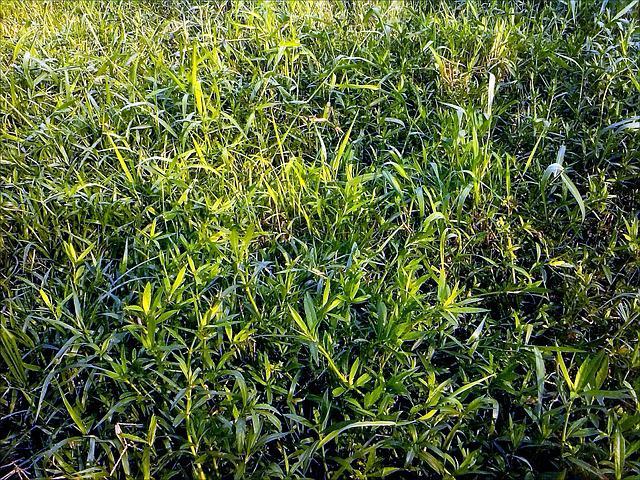
Don’t let the weeds from establishing you the greenest lawn in the neighborhood.
Weeds on the lawn can be a real problem. Their presence not only gets in the way of establishing a uniform dark turf, but they are also bad for the health of your grass. Weeds compete with grass for nutrients, water, and space which can ruin the turf’s health.
If there are only a few weeds in your grass, you can remove them manually now and then. However, make sure that you take them out before they set seeds and remove them entirely from the roots, or they will come back.
Alternatively, you can switch to fertilizer that contains weed killer. However, if you do not want to use any chemicals in your yard, there are many ways to get rid of weeds naturally and permanently as well. Read this article to find out.
RELATED: Common Lawn Weeds and How To Identify Them | A Comprehensive Guide
Fill Any Gaps
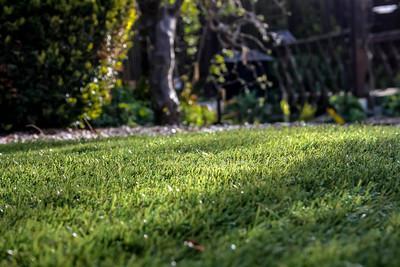
A lawn with gaps and bare spots is the best place for weeds to grow.
Another reason your lawn does not look as green as your neighbor’s lawn is that you have a thin or patchy turf. There could be many causes behind the presence of brown patches in your yard. In order to establish a lush green turf, you will first have to eliminate the reason behind the presence of brown or bare patches on your lawn.
Once done, you can overseed your lawn to get a uniform green turf. Here’s how to do it:
- Get the right seeds that match the existing grass on your lawn.
- Remove all the dead grass from the area you intend to reseed.
- Aerate the soil and distribute the seeds.
- Cover the grass seeds with a thin layer of soil and water regularly.
- You can also put mulch on your grass seed to protect them from the elements.
Aerate The Soil
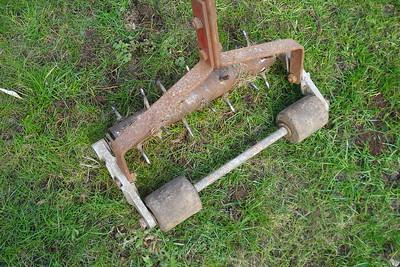
Soil compaction can be a real hurdle towards establishing a thick green lawn.
Last but not least, you will need to aerate your lawn every so often. Over time, due to foot traffic and other lawn activities, the soil starts to compact, creating a problem for root growth. As a result, the grass starts to become weak and appear pale.
By aerating the soil, you will make it suitable for root growth and increase air, water, and nutrient infiltration into the deeper layers of the ground. As a result, grass will grow rapidly and appear healthy and green.
The timing of soil aeration is also important. For example, warm-season grasses should be aerated in late spring or early summer. In contrast, cool-season grasses are best aerated in early spring or fall, and for lawn aeration, we highly recommend that you use a core aerator.
Conclusion | How To Make Grass Green
While many of the above-mentioned tips and tricks seem simple, they can become quite a burden when merged. The key is to distribute different tasks over time and do one thing at a time. Keeping your lawn green is worth the effort!
It is a place where you spend many of your evenings. It is where you probably look first when coming back home, and it is where you hold most of your outdoor gatherings. So, keep it green otherwise, it will become just a sore for the eyes.
Frequently Asked Questions
What is the best fertilizer to make grass green?
The choice of the best fertilizer to make your grass grow and green depends on your soil conditions. So, we highly recommend that you get a soil test. In general, however, experts suggest using nitrogen and iron fertilizer to green the grass.
Why has my grass gone yellow?
The grass in your turn might turn yellow if it is not getting enough water or nutrients. Another reason for yellowing turf could be the grass entering dormancy. During this time, no amount of watering and fertilization will turn it green. So, know your grass and save the effort.
Is it better to cut the grass short or long?
The decision to cut the grass short or long depends on the grass type. Some grasses, such as Bentgrass, need to be mowed high for best growth, while others grow best when trimmed short, like Bermuda grass. However, as a rule of thumb, never cut your grass more than one-third of its original length.
Does brown grass mean it is dead?
Brown grass always does not mean that the grass is dead. Sometimes it could be due to lawn disease, while other times, it results from the grass entering dormancy. However, most of the time, brown grass means improper care, such as insufficient water and nutrients.
How do you wake up dormant grass?
It is not recommended to try waking up dormant grass. It is a natural phenomenon, and trying to promote growth at this time will put your grass under stress. However, if the grass is dormant for unnatural reasons, you should first identify and eliminate the reason for dormancy and then water, fertilize and reduce traffic stress on your grass.
Sources For Further Reading
How to keep your lawn green and healthy – University of Alberta
Spring into greener lawns – K-State Research and Extension News
We can make lawn grass greener – Northwestern University







